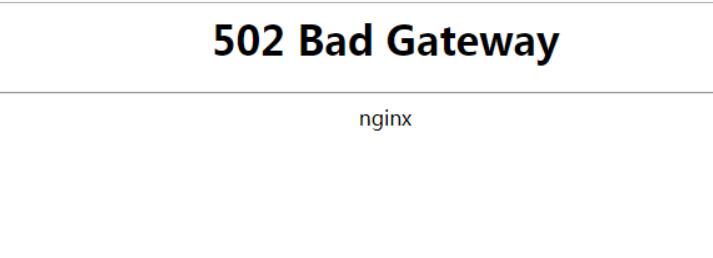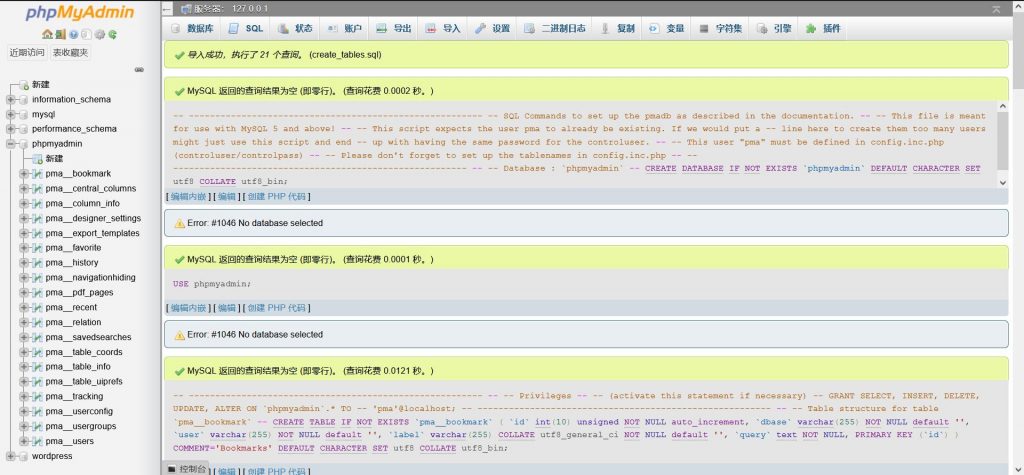教程所用环境:CentOS 7/PHP 7.4/Negix 18.0/MariaDB 10.5/WordPress 5.9/BT Panel 7.9/phpMyAdimn 5.1
1. 为什么要手动安装
本人使用的是腾讯云所提供的 WordPress 镜像,这个镜像中,是默认携带了宝塔面板的。如图 1 所示。

因此,我们可以选择从宝塔面板中的应用商店来一键自动安装 phpMyAdmin。但是,实际上事实并没有我们想象的那么美好。
本人在安装好这个镜像后,将 WordPress 升级到了 5.9,并且宝塔面板也升级到了 7.9。随后使用宝塔面板安装 phpMyAdmin 后,就会发现,PHP 服务离奇的停止了运行,如图 2 所示。

同时,这时在浏览器上输入 http://ip:888,会显示”502 bad gateway“错误,无法正常使用,如图 3 所示。且按照网上所说的更改 phpMyAdmin 中的 PHP 版本设置后依然无法正常访问。

在上网查询各种解决方法后未果后,本人出于好奇,手贱的重启了一次服务器。结果发现 phpMyAdmin 仍然无法正常使用,但是 PHP 服务正常运行。同时 MySQL 服务停止运行,并且无法正常启动,如图 4 所示。由于本人对 Linux 数据库运维等并不熟悉,因此目前尚不知道原因。

可见,目前宝塔面板安装 phpMyAdmin 后可能会出现一些问题,但是手动安装就不会有这样的问题产生。因此在重置服务器后本人选择手动安装 phpMyAdmin。
2. 安装方法
2.1 下载并解压 phpMyAdmin
首先前往 phpMyAdmin 官方网站下载源码包,建议下载 tar.gz 格式的源码包,并使用宝塔面板、FTP 协议或者 MobaXterm 软件上传到服务器中。或者直接使用 Linux 命令下载。
转到下载目录:
cd /usr/local/src
使用 wet 命令进行下载:
wget https://files.phpmyadmin.net/phpMyAdmin/5.1.3/phpMyAdmin-5.1.3-all-languages.tar.gz
解压文件到当前目录:
tar zxvf phpMyAdmin-5.1.3-all-languages.tar.gz
2.2 将 phpMyAdmin 移动到网站目录下
在腾讯云 ESC 自带的 WordPress 镜像中,已经默认为 phpMyAdmin 准备好了一个安装目录,具体可以通过下面的方法来查看:
(1). 首先登录腾讯云服务器控制台,转到应用管理,上面会显示 Negix 配置文件的默认位置,如图 5。

输入下面的命令,即可查看详细的 Negix 配置:
vim /www/server/nginx/conf/nginx.conf
找到有着这样内容的几行(输入:q 退出 vim):
server { listen 888; root /yourdirectory/phpmyadmin;
其中,”root“后面的目录,就是该镜像为 phpMyAdmin 准备的默认安装目录。
输入下面的命令,将解压后的文件移动到默认的目录下。(如果你使用的不是腾讯云服务器加上该镜像,而是任意一台其他的服务器,那么你可以自行创建一个安装目录,并将 phpMyAdmin 移动到这个目录下,并在最后一步的解析时将 root 后的路径设置成这个你自己创建的安装目录即可)
mv phpMyAdmin-5.1.3-all-languages /yourdirectory/phpmyadmin
至此,phpMyAdmin 安装成功
3. phpMyAdmin 配置方法 [1]
首先进入到你自己的 phpMyAdmin 的安装目录下,并转到 ./libraries 文件夹下:
cd /yourdirectory/phpmyadmin/libraries
编辑 config.default.php 文件:
vim config.default.php
修改如下几处(数据库用户名和密码可以用腾讯云应用管理处提供的命令来查询):
/** * MySQL hostname or IP address * * @global string $cfg['Servers'][$i]['host'] */ $cfg['Servers'][$i]['host'] = '127.0.0.1'; /** * MySQL user * * @global string $cfg['Servers'][$i]['user'] */ $cfg['Servers'][$i]['user'] = '你的数据库用户名'; /** * MySQL password (only needed with 'config' auth_type) * * @global string $cfg['Servers'][$i]['password'] */ $cfg['Servers'][$i]['password'] = '你的数据库密码';
ESC,:wq 保存,配置完成。
4. 配置 Negix 解析 phpMyAdmin[2]
完成上一步后,此时在浏览器中输入 http://ip:888,还是会显示 502 错误。原因是腾讯云镜像虽然给我们准备好了一个推荐的安装目录,但是并没有帮我们做好解析工作,因此 Negix 中的默认解析配置还存在问题,需要我们自己重新配置解析。
重新打开 Negix 配置文件,找到上面提到的那个 server,将这个 server 删掉,并替换成以下内容(如果你使用的不是腾讯云服务器加上该镜像,那么只需要将这个配置中 root 后面的目录换成你自己创建的安装目录即可):
server { listen 888; # 如果你不想使用888这个端口访问phpMyAdmin,请将其改为其他端口,如12345 root /yourdirectory/phpmyadmin; # 这里写你的phpMyAdmin的根目录 index index.html index.php; location / { } location ~ \.php$ { fastcgi_pass 127.0.0.1:9000; fastcgi_index index.php; fastcgi_param SCRIPT_FILENAME $document_root$fastcgi_script_name; include fastcgi_params; } }
重启 Negix
systemctl restart nginx
浏览器访问 http://ip:888,发现可以正常访问,如图 5(登录用户名和密码即为 MySQL 数据库的用户名和密码)。

5. 其他的一些问题
(1). 登陆后报错:” 缺少变量 $cfg [‘TempDir’] (./tmp/)无法访问,phpMyAdmin 无法缓存模板文件,所以会运行缓慢 “,如图 6。

解决方法 [3]:进入 phpMyAdmin 的安装目录,新建 tmp 文件夹即可。
cd /yourdirectory/phpmyadmin mkdir tmp chmod 777 tmp
关闭页面后再次打开,问题解决。
(2). 登录后报错:” 配置文件现在需要一个短语密码。”,如图 7。

解决方法 [4]:打开 phpMyAdmin 下的配置文件 (/ 你的 phpMyAdmin 安装目录 /libraries/config.default.php),将如下内容进行修改:
/** * The 'cookie' auth_type uses AES algorithm to encrypt the password. If * at least one server configuration uses 'cookie' auth_type, enter here a * pass phrase that will be used by AES. The maximum length seems to be 46 * characters. * * @global string $cfg['blowfish_secret'] */ $cfg['blowfish_secret'] = '你设置的密码,最好有32位,不然还会报错说密码长度太短';
关闭页面后再次打开,问题解决。
(3). “phpMyAdmin 高级功能尚未完全设置,部分功能未激活”,如图 8。

解决方法 [5]:
首先找到 / 你的 phpMyAdmin 安装目录 /sql/create_tables.sql 文件,并想办法把它下载到你的电脑上(可以用宝塔面板)。
浏览器访问 http://ip:888,登录 phpMyAdmin,选择导入,并选择刚才下载下来的 create_tables.sql 文件,如图 9。

导入完成后的界面如图 10 所示,可以看出右侧多了一个叫做”phpmyadmin” 的数据库。

打开 phpMyAdmin 下的配置文件 (/ 你的 phpMyAdmin 安装目录 /libraries/config.default.php),找到下列内容并修改:
/** * Database used for Relation, Bookmark and PDF Features * (see sql/create_tables.sql) * - leave blank for no support * SUGGESTED: 'phpmyadmin' * * @global string $cfg['Servers'][$i]['pmadb'] */ $cfg['Servers'][$i]['pmadb'] = 'phpmyadmin'; /** * Bookmark table * - leave blank for no bookmark support * SUGGESTED: 'pma__bookmark' * * @global string $cfg['Servers'][$i]['bookmarktable'] */ $cfg['Servers'][$i]['bookmarktable'] = 'pma__bookmark'; /** * table to describe the relation between links (see doc) * - leave blank for no relation-links support * SUGGESTED: 'pma__relation' * * @global string $cfg['Servers'][$i]['relation'] */ $cfg['Servers'][$i]['relation'] = 'pma__relation'; /** * table to describe the display fields * - leave blank for no display fields support * SUGGESTED: 'pma__table_info' * * @global string $cfg['Servers'][$i]['table_info'] */ $cfg['Servers'][$i]['table_info'] = 'pma__table_info'; /** * table to describe the tables position for the designer and PDF schema * - leave blank for no PDF schema support * SUGGESTED: 'pma__table_coords' * * @global string $cfg['Servers'][$i]['table_coords'] */ $cfg['Servers'][$i]['table_coords'] = 'pma__table_coords'; /** * table to describe pages of relationpdf * - leave blank if you don't want to use this * SUGGESTED: 'pma__pdf_pages' * * @global string $cfg['Servers'][$i]['pdf_pages'] */ $cfg['Servers'][$i]['pdf_pages'] = 'pma__pdf_pages'; /** * table to store column information * - leave blank for no column comments/mime types * SUGGESTED: 'pma__column_info' * * @global string $cfg['Servers'][$i]['column_info'] */ $cfg['Servers'][$i]['column_info'] = 'pma__column_info'; /** * table to store SQL history * - leave blank for no SQL query history * SUGGESTED: 'pma__history' * * @global string $cfg['Servers'][$i]['history'] */ $cfg['Servers'][$i]['history'] = 'pma__history'; /** * table to store recently used tables * - leave blank for no "persistent" recently used tables * SUGGESTED: 'pma__recent' */ $cfg['Servers'][$i]['recent'] = 'pma__recent'; /** * table to store favorite tables * - leave blank for no favorite tables * SUGGESTED: 'pma__favorite' */ $cfg['Servers'][$i]['favorite'] = 'pma__favorite'; /** * table to store UI preferences for tables * - leave blank for no "persistent" UI preferences * SUGGESTED: 'pma__table_uiprefs' */ $cfg['Servers'][$i]['table_uiprefs'] = 'pma__table_uiprefs'; /** * table to store SQL tracking * - leave blank for no SQL tracking * SUGGESTED: 'pma__tracking' * * @global string $cfg['Servers'][$i]['tracking'] */ $cfg['Servers'][$i]['tracking'] = 'pma__tracking'; /** * table to store user preferences * - leave blank to disable server storage * SUGGESTED: 'pma__userconfig' * * @global string $cfg['Servers'][$i]['userconfig'] */ $cfg['Servers'][$i]['userconfig'] = 'pma__userconfig'; /** * table to store users and their assignment to user groups * - leave blank to disable configurable menus feature * SUGGESTED: 'pma__users' * * @global string $cfg['Servers'][$i]['users'] */ $cfg['Servers'][$i]['users'] = 'pma__users'; /** * table to store allowed menu items for each user group * - leave blank to disable configurable menus feature * SUGGESTED: 'pma__usergroups' * * @global string $cfg['Servers'][$i]['usergroups'] */ $cfg['Servers'][$i]['usergroups'] = 'pma__usergroups'; /** * table to store information about item hidden from navigation tree * - leave blank to disable hide/show navigation items feature * SUGGESTED: 'pma__navigationhiding' * * @global string $cfg['Servers'][$i]['navigationhiding'] */ $cfg['Servers'][$i]['navigationhiding'] = 'pma__navigationhiding'; /** * table to store information about saved searches from query-by-example on a db * - leave blank to disable saved searches feature * SUGGESTED: 'pma__savedsearches' * * @global string $cfg['Servers'][$i]['savedsearches'] */ $cfg['Servers'][$i]['savedsearches'] = 'pma__savedsearches'; /** * table to store central list of columns per database * - leave blank to disable central list of columns feature * SUGGESTED: 'pma__central_columns' * * @global string $cfg['Servers'][$i]['central_columns'] */ $cfg['Servers'][$i]['central_columns'] = 'pma__central_columns'; /** * table to store designer settings * - leave blank to disable the storage of designer settings * SUGGESTED: 'pma__designer_settings' * * @global string $cfg['Servers'][$i]['designer_settings'] */ $cfg['Servers'][$i]['designer_settings'] = 'pma__designer_settings'; /** * table to store export templates * - leave blank to disable saved searches feature * SUGGESTED: 'pma__export_templates' * * @global string $cfg['Servers'][$i]['export_templates'] */ $cfg['Servers'][$i]['export_templates'] = 'pma__export_templates';
关闭页面后再次打开,问题解决。
6. 配置 phpMyAdmin 使用 https 和域名访问。
想要使用域名和 https 来访问 phpMyAdmin,只需要将 Negix 的配置修改一下即可 [6]。下面贴上一个示例配置,大家可以参照此进行修改:
server { listen 888 ssl; # 如果你不想使用888这个端口访问phpMyAdmin,请将其改为其他端口,如12345 server_tokens off; keepalive_timeout 5; root /yourdirectory/phpmyadmin; # 这里写你的phpMyAdmin的根目录 index index.php index.html; server_name www.yourdomain.com; # 这里写你的域名 ssl_certificate yourSSLcertificate.crt; # 这里写证书文件名称 ssl_certificate_key yourSSLcertificate.key; # 这里写私钥文件名称 ssl_session_timeout 5m; ssl_protocols TLSv1 TLSv1.1 TLSv1.2; ssl_ciphers ECDHE-RSA-AES128-GCM-SHA256:HIGH:!aNULL:!MD5:!RC4:!DHE; ssl_prefer_server_ciphers on; location / { } location ~ \.php$ { fastcgi_pass 127.0.0.1:9000; fastcgi_index index.php; fastcgi_param SCRIPT_FILENAME $document_root$fastcgi_script_name; include fastcgi_params; } }
这样配置完成后,在浏览器中输入 https://www.yourdomain.com:888/ 就可以访问你的 phpMyAdmin 页面了。

不建议对公网开放数据库功能
好的,多谢提醒。我这篇文章中说的方法仅作教程用,实际并未开放。